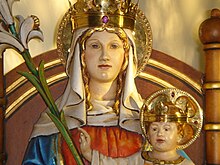Even in the eleventh century, when this story begins, the village of Little Walsingham was a thriving place, located mid-way between Norwich (then England's second city) and the wealthy town of King's Lynn.
Richeldis de Faverches was a Saxon noblewoman, married to the Lord of the Manor of Walsingham Parva. He died leaving her a young widow with a son, Geoffrey.
We know that Richeldis had a deep faith in God and devotion to Mary. We know too of her reputation for good works in care and generosity towards those around her.
At this time there was a great deal of interest in the Holy Land and people undertook long and often dangerous pilgrimages there. Christian armies were soon to be engaged in a number of Crusades to liberate the holy sites from Muslim control and it is believed that Geoffrey eventually joined one of those Crusades as an expression of his Christian faith.
For Richeldis, however, the life of prayer and good works was rewarded by a vision in the year 1061. In this vision she was taken by Mary to be shown the house in Nazareth where Gabriel had announced the news of the birth of Jesus. Mary asked Richeldis to build an exact replica of that house in Walsingham. This is how Walsingham became known as England's Nazareth.
The vision was repeated three times, according to legend, and retold through a fifteenth century ballad. The materials given by Richeldis were finally constructed miraculously one night into the Holy House, while she kept a vigil of prayer.
Although we cannot be certain that this story represents all the details of historical fact, we do know that in passing on his guardianship of the Holy House, Geoffrey de Faverches left instructions for the building of a Priory in Walsingham. The Priory passed into the care of Augustinian Canons somewhere between 1146 and 1174.
It was this Priory, housing the simple wooden structure Richeldis had been asked to build, which became the focus of pilgrimage to Walsingham. Royal patronage helped the Shrine to grow in wealth and popularity, receiving visits from Henry III, Edward II, Edward III, Henry IV, Edward IV, Henry VII and Henry VIII, who finally brought about its destruction in 1538.
After nearly four hundred years, the 20th century saw the restoration of pilgrimage to Walsingham as a regular feature of Christian life in these islands, and indeed beyond.
In 1897, there was a Roman Catholic pilgrimage to the restored 14th century Slipper Chapel, now at the centre of the Roman Catholic National Shrine.
Fr Hope Patten*, appointed as Vicar of Walsingham in 1921, ignited Anglican interest in the pre-Reformation pilgrimage. It was his idea to base a new statue of Our Lady of Walsingham on the image depicted on the seal of the medieval Priory.
In 1922, this statue was set up in the Parish Church of St. Mary, and regular pilgrimage devotion followed. From the first night that the statue was placed there, people gathered around it to pray, asking Mary to join her powerful prayer with theirs. This work of intercession continues to this day.
Throughout the 1920's, the trickle of pilgrims became a flood of large numbers, for whom eventually a Pilgrim Hospice was opened (a hospice is technically the name of a place of hospitality for pilgrims) and in 1931, a new Holy House encased in a small pilgrimage church was dedicated, and the statue translated there with great solemnity. In 1938 that church was enlarged to form the Anglican Shrine, more or less as we know it today. Fr Patten combined the posts of Vicar and Priest Administrator of the Shrine until his death in 1958.
As pilgrim numbers continued to grow, so did the needs of those who came. St Joseph’s House was opened for pilgrims with special needs and Richeldis House opened in 1991 to provide yet more accommodation.
During the build up to the millennium celebrations of 2000 a new Refectory was planned. HRH Princess Alexandra opened it in 2001 during a year of outreach when the statue of Our Lady visited five Cathedrals in Britain for a series of Regional Festivals. 2004 saw the Our Lady of Walsingham visiting a wide variety of different venues - a hospital, a prison, an airport, an army barracks, an Oxford college, a school - in an entirely new form of outreach called Magnificat. The two months culminated in wonderful service of celebration in York Minster. In 2005, the Shrine gardens were re-designed and replanted to a design by Tessa Hobbs and this has been followed by the re-working of the Shrine Church's west front entrance piazza and the building of the new Altar of the Mysteries of Light in the garden. In June 2007 work began on the Milner Wing - containing a Welcome Centre, a new Reception area and a range of en-suite bedrooms. Pilgrims and friends helped raise £2 million towards the cost of this major undertaking. The new building was handed over in October 2008.


